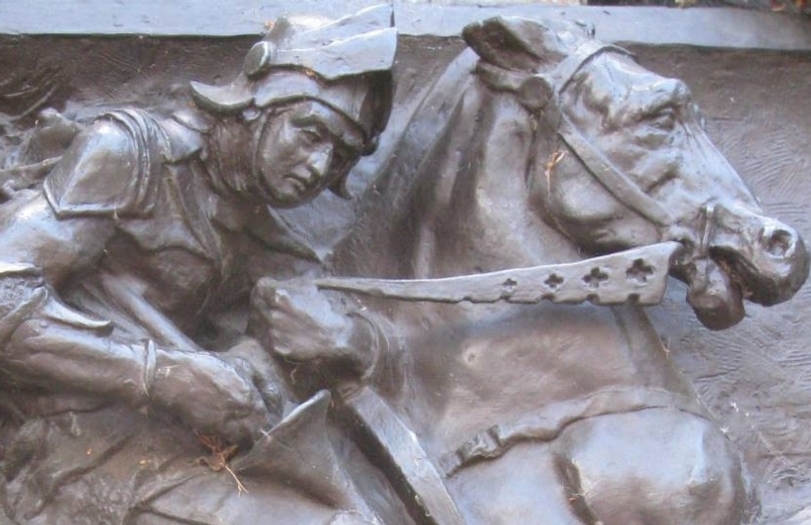St Peter's Stories - Part One
Since it was built around 1100, the church of St Peter’s in Sandwich, Kent has borne witness to incredible things – war, scientific discovery, tremendous acts of compassion and the presence of great minds. In this series of blogs, we would like to peel back the layers and expose some of what makes St Peter’s such a special place for the people of Sandwich...
War and Pete's
Just like Doctor Who, St Peter’s has had many faces.
The first of these appeared around 1100, in the decades following the Norman Conquest. Back then, Sandwich wasn’t the landlocked town it is today, rather it was an easily accessible port from the Continent. It was ideal for bringing in trade goods and later, pilgrims heading to the shrine of St Thomas Becket in Canterbury. Over time, it would even become one of the famous Cinque Ports of the high medieval period.
In fact, Sandwich’s importance as a port would doom the first version of St Peter’s church.
We are however, getting ahead of ourselves.
The first St Peter’s was typical of Norman churches across the country – a relatively squat building, with stone arches being the dominant feature. It was a community hub not only for locals, but for a steady stream of pilgrims and travellers. At a time when traveling was far more dangerous than it is today, praying for a successful journey, or giving thanks upon returning home was an important task.
Had it survived, it is possible that the original St Peter’s would have been slowly modified and added onto over time. However, this was not to be. The first church only lasted just over a hundred years.
You see, by 1215, King John had royally mucked things up. He had made the classic mistake of too heavily levying a form of tax on his barons – the scutage, or payment made in lieu of military support.
Having to pay levies a total of eleven times within in the space of a few years annoyed the barons, who ended up rebelling and forcing John to sign the Magna Carta, curbing his power. That wasn’t nearly the end of the matter, however. King John managed to round up some loyal barons and chased the rebels across the country, harrying them and picking them off.
Seeking military assistance, the rebel barons made calls to King Louis VIII of France, who, by marriage, had his own tenuous claim to the English throne. Never one to pass up a kingdom for the taking, Louis quickly assembled an army and sailed across the Channel.
It was May 1216 when war came to Sandwich. The first sign of the coming conflagration would have been sails on the horizon, spotted by the fisherman who sailed daily from the port. Soon a French force landed in nearby Thanet and, eager to crush local opposition, assaulted Sandwich.
There are no reliable eye-witness accounts of this first great attack on Sandwich. However we can fairly easily gain a picture of what may have happened from what we know of the period. We know that without the professional, salaried armies that we have today, many invading forces of the 13th century were motivated by looting and pillage. Thus the town would have been comprehensively stripped of anything of value – gold, jewels, cloth and anything that could easily be stowed in a bag. Then, when anything worth taken was gone, soldiers would have gone about putting the town to the torch. This burning was a form of ‘scorched earth policy’ that meant that the English would have a hard time re-establishing the town as a viable enterprise.
As the spiritual and physical heart of the town, St Peter’s would have been one of the first buildings to be burned. Flaming torches would have been thrown through the few, small windows of the church and the wooden and cloth furnishings would have quickly caught alight. With a great deal of flammable fuel, the fire would have quickly reached very high temperatures, cracking the stone and causing the structure to fall into a smouldering heap.
The French would soon move on from Sandwich, leaving death and destruction in their wake. They would harry London and Winchester before withdrawing the next year, once Henry III was safely ensconced on the throne.
They make them tough around Sandwich and soon a new settlement emerged from the ruins of the old town. Funnily enough, it was the French who were responsible for rebuilding the structure of St Peter’s as we see it today, when Carmelite monks, or ‘Whitefriars’ came over from France to establish a new monastic cell later in the 13th century.
The story of what happened next to St Peter’s church – the Black Death, the decay of the church and its revival through some very special Strangers will be the subject of our next ‘St Peter’s Story’. We hope you’ll join us to learn more.
Mike Stuchbery - Volunteer

